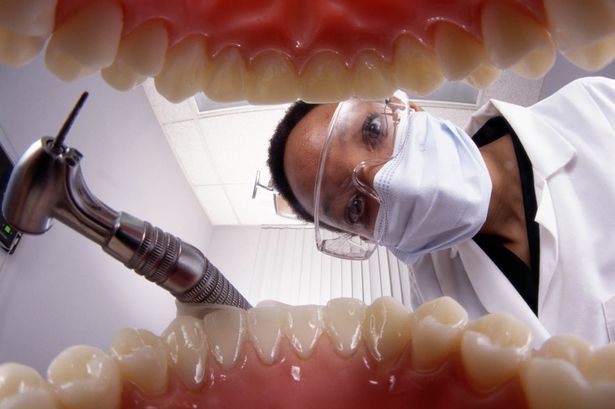Some people have had painful encounters with the dental “drill” because they weren’t properly numbed (or perhaps not numbed at all). Not surprisingly, if this has happened you are likely to feel terrified of the “drill” (or handpiece in layman’s speak). Thinking of the sound alone will make you feel very anxious.
However, there should be no pain once the tooth is properly numb – only vibration and light pressure. Once you have learned to associate the sound of the handpiece with pain though, it can be quite hard to unlearn this association.
Few people like the sound of the handpiece, even if they haven’t had bad experiences in the past. Electric handpieces are quieter than traditional handpieces and thankfully are becoming more commonplace – they are quite a bit more expensive though. But also, the traditional air-driven models have become much quieter over the years (some brands are quieter than others).
People may also associate the handpiece with an attack on their bodily integrity. It may be useful to know that when a dentist cleans out an area of decay, this area is actually made of a mushy material, and not hard like the enamel on the tooth.
Also, some people are worried that the handpiece might slip and injure them. If this is a worry for you, please let your dentist know about your concerns!
There are many ways of dealing with this fear, and you should choose the tip(s) which you feel will work best for you. Some are based on distraction, others are based on exposure (of course, you can use a mixture of both).
Distraction
Blending out the sounds:
Bringing an mp3 or CD player and playing your favourite music is a tip frequently mentioned on our forum. Some people recommend turning up the volume really high and choosing fast tunes without lengthy gaps in between the tracks, to blend out any sounds.
Others prefer more soothing music, relaxation tracks, or tracks with nature sounds such as waves or tropical thunderstorms.
It is helpful to have the “Pause” button handy in case you want to communicate with your dentist.
Choose earphones that don’t pop out easily.
Some dentists provide CD or mp3 players, but most don’t. The reason is hygiene regulations (they would have to be cleaned in between patients). But all dentists will let you bring your own mp3 or CD player.
Some mp3 tracks are specifically designed for blending out the sounds of the handpiece.
Getting comfortable:
Some people much prefer to keep their eyes closed during treatment.
You can bring a blanket to make you feel more comfortable and secure. Some people also like holding their favourite soft toy.
Make a conscious effort to relax – it is impossible to be anxious and relaxed at the same time. Have a stop signal agreed with your dentist in case you need to take a break, or in case you need more numbing. There are various relaxation techniques, such as concentrating on your breathing, deliberately relaxing the muscles which you find tense up when you’re anxious (for example, your shoulder muscles), and self-hypnosis.
Do not hesitate to ask for anaesthetic top-up if you don’t feel completely numb! Many people think that they can only have what they are originally given, but it’s easy to give a top-up.
If you are worried about not being numb, ask your dentist to check that you are numb (for example, with the explorer) before using the handpiece.
Stress balls are malleable balls which can be squeezed with one or both hands to reduce stress and tension. They are available from places like toy shops, drug stores, and sports shops.
Watching TV or DVDs:
A few dentists provide entertainment systems such as TV screens (sometimes with a selection of DVDs – you can also bring your own) or even virtual-reality goggles.
Exposure
Getting familiar with the equipment:
It can be helpful to be able to look at, touch and hear the handpiece before it is used. Our expectations about the size and noise of the handpiece are often exaggerated, and getting familiar with the handpiece can help put things into perspective.
Ask your dentist if they can show you the handpiece and ask if you can touch it. If this sounds too scary, you can ask for a prophy handpiece (used for cleanings) with a rubber prophy cup (see photo) first. Ask your dentist to show you the instrument like they would show it to a child patient. A lot of dentists are familiar with techniques to make children feel more confident and comfortable about treatment.
Seeing what is happening:
Sometimes it helps to see what is happening. Our imagination can often run wild. Actually seeing what is happening, with the help of a mirror, can put things into perspective.
Preparing for the sounds and sights:
Some people find it useful to desensitize themselves to the sounds they may encounter. For example, using an electric toothbrush can help. You can play around with the way sound is amplified by brushing your teeth while having a shower, and letting the water run over your ears. This can be very anxiety-provoking at first, so only try it if you think you can handle it.
Depending on the nature and extent of your phobia, you may find it helpful to watch a video where a handpiece is used. **TRIGGER WARNING** Please do not watch this if you feel it might increase your fears! Although this video might not be the best (the handpiece is an old-style one rather than the quieter more modern type), it is quite sensitively done.


